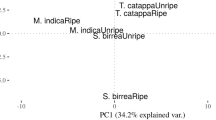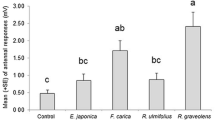Abstract
Several ceratopogonid flies are attracted to cantharidin and ingest it from both cantharidin-baits and from meloid beetles, one of the few known natural sources for cantharidin. Because meloids are absent in northern Bavaria, and certain canthariphilous flies of the genusAtrichopogon are temporarily associated with certain plants (Apiaceae, Aristolochiaceae), it was suggested that canthariphilous ceratopogonids might be generally attracted by chemically similar plant-derived compounds. At first the seasonal fluctuating attractancy, sex ratio and behaviour ofA. oedemerarum Storå was studied at cantharidin baits. Synthetic cantharidin analogues exhibited an attractancy forA. oedemerarum if the exo,exo-7-oxabicyclo[2.2.1]heptane skeleton of cantharidin was associated with a 2,3-dicarboxylic anhydride or a 2,3-γ-lactone. According to structure-activity studies, the analogues seem to fit best into the active site of the receptor if the carbonyl function of the γ-lacton is in the exo- and 2-position. This is the first report indicating that molecules other than cantharidin are attractive for canthariphilous insects.
Similar content being viewed by others
References
Carrel, J. E., and Eisner, T., Science183 (1974_ 755.
Carrel, J. E., Doom, J. P., and McCormick J. P., J. Chem. Ecol.12 (1986) 741.
Young, D. K., Great Lakes Ent.17 (1984) 187.
Young, D. K., Great Lakes Ent.17 (1984) 195.
Fey, F., Beitr. Ent.4 (1954) 180.
Dettner, K., Z. Umweltchem. Ökotox.4 (1989) 29.
Storå, R., Not. Ent.29 (1939) 16.
Mayer, K., Z. Parasitenk.21 (1962) 257.
Havelka, P., Z. Arbeitsgem. Österr. Entomologen30 (1979) 117.
Havelka, P., Beitr. naturk. Forsch. SüdwDtl.39 (1980) 153.
Havelka, P., Mosqu. News42 (1982) 524.
Bochis, R. J., and Fisher, M. H., Tetrahedron Letts.,16 (1968) 1971.
Graziano, M. J., Pessah, I. N., Matsuzawa, M., Casida, J. E., Mol. Pharmac.33 (1988) 706.
Matsuzawa, M., Graziano, M. J., and Casida, J. N., J. Agric. Food. Chem.35 (1987) 823.
Havelka, P., Isr. J. Entomol.15 (1981_ 119.
McCormick, J. P., and Carrell, J. E., Pheromone Biochemistry, pp. 307–350. Ed. G. D. Prestwich. Academic Press 1987.
Gönitz, K., Arb. phys. angew. Ent. (Berlin-Dahlem)4 (1937) 116.
Author information
Authors and Affiliations
Rights and permissions
About this article
Cite this article
Frenzel, M., Dettner, K., Wirth, D. et al. Cantharidin analogues and their attractancy for ceretopogonid flies (Diptera: Ceratopogonidae). Experientia 48, 106–111 (1992). https://doi.org/10.1007/BF01923620
Received:
Accepted:
Published:
Issue Date:
DOI: https://doi.org/10.1007/BF01923620




